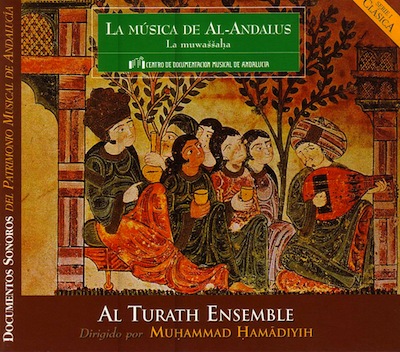La Muwassaha
Detail DS-0123 You can buy this record here 11 € La Muwassaha La Musica de Al-Andalus
LA MÚSICA DE AL-ANDALUS La muwassaha
warlah de maqam hijaz/warlah of the maqam hijaz /warlah à maqam hijaz
1. samáci 7'05" 2. muwashshaha "yá ghusayna-l-báni" 3'17" 3. muwashshaha "má-htiyáli" 5'38" 4. muwashshaha "hajarni habibi" 1'40" 5. muwashshaha "yá futina-l-ghuzlán" 4'35" 6. muwashshaha "unqu-l-malih" 3'45" 7. dúláb 2'50" 8. taqsim 1'48" 9. Iayáli "yá layli ya ayni" 5'28" 10. gasidah 7'26" 11. qad "yá mayilah alá-I-ghusún ayni" 6'12" 12. mawwál 4'40" 13. qad "füq an-nakhil" 4'50" 14. qad "al-bulbul nagha aghusni-l-fill" 4’50" 15. qad "gadduka-l-mayyas yá umri" 7’02" 16. qad "bini w-binak háru-l-awázü" 2’50”
Tiempo total 74'56"
|
About THE ANDALUSI WASLAH OF ALEPPO, SYRIA
WASLAH Awaslah is the performance of up to eight muwashshahát (plural of muwashshaha) in succession together with an instrumental introduction. Common to all sections of such a waslah cycle is the principle maqám row, whereby the combination of pieces can comprises the works of several poets and composers. The muwashshah composition played at the beginning of a cycle may have a longer longer wazn than the muwashsahát that follow. A total of 22 waslát (plural of waslah) are known in Aleppo, each of them named according to the maqám row to which it belongs (for example, waslah of maqám rást, waslah of maqám hijáz, waslah of maqám sikáh).
MAQÁM The term maqám designates a modal framework in the music of the Arabs. It denotes not just the a intervallic distances between tones of specifics order, but rather the mood created throught realization and presentation of the modal framework based on such on order of intervallic distances, which themselves make up what is called the maqám row or the maqám mode. From a historical point of view, the term maqám became a common property of Arabic-Islamic musical scholars in the fourtenth century. The maqám represents a unique improvisatory process in the art music of the Arabs and in the art music of a large part of the world encompassing the cultures of North Africa, West and Central Asia. The structure of a maqám depends upon the extent upon to which the tonal and temporal factors exhibit a fixed or free organization. The tonal-spatial component is organized, molded and emphasized to such a degree that it represents the essential and decisive factor in the maqám, whereas the temporal-rhythmic aspect in this music is not subject to a definite form of organization. In this very circumstance lies the most essential feature of the maqám phenomenon, that is, a free organization of the rhythmic-temporal and an obligatory and fixed organization of the tonal spatial aspect. The maqám is thus not subject to rules of organization where the temporal parameter is concerned, that is it has neither a regularly recurring and stablished bar scheme nor an unchanging tactus. The rhythm characterizes the performer's style and is dependent on his manner and technique of playing or singing but is never characteristic of the maqám as such. The singular feature of this form is one which is not built upon motifs, their elaboration, variation and development, but throught a number of melodic passages of different lengths that realize one or more tone-levels in space and thus establish the various phases in the development of the maqám. The maqám is based upon a systematic realization of tone-levels which gradually move upwards form the lower to the higher registers until the climax is reached, at which point the form is completed. The realization of a truly convincing and original maqám requires a creative faculty like that of a composer of genius. Nevertheless, this phenomenon can only in part be considered as a composed form because no maqám can be identical with any other: each time it is recreated as a new composition. The compositional factor shows itself on the predetermined tonal-spatial organization of the fixed number of tone-levels without repetitions, while the improvisational aspects freely unfolds in the rhythmic-temporal layout. The interpley of composition and improvisation is one of the most distinctive features of the maqám phenomenon.
WAZN Genres with a fixed rhythmic-temporal organization have clear, compact, regularly recurring measures which cause an organized, easily recognizable segmentation of time. The muwashshah belongs to this genre. On the other hand, genres with a free rhythmic-temporal organization have a rhythmic - temporal structure without regularly recurring measures and motives and without displaying a fixed meter (pulse). The taqsim belongs to this genre. Nevertheless, the rhythmic pattern in Arabian music is colled wazn, literally "measure". Such patterns are also known by the names usúl, mizán y darb. The Arabian wazn repertoire is comprised of approximately 100 cycles. |

